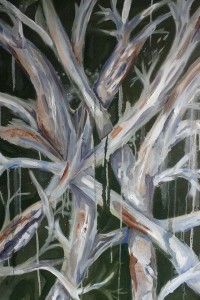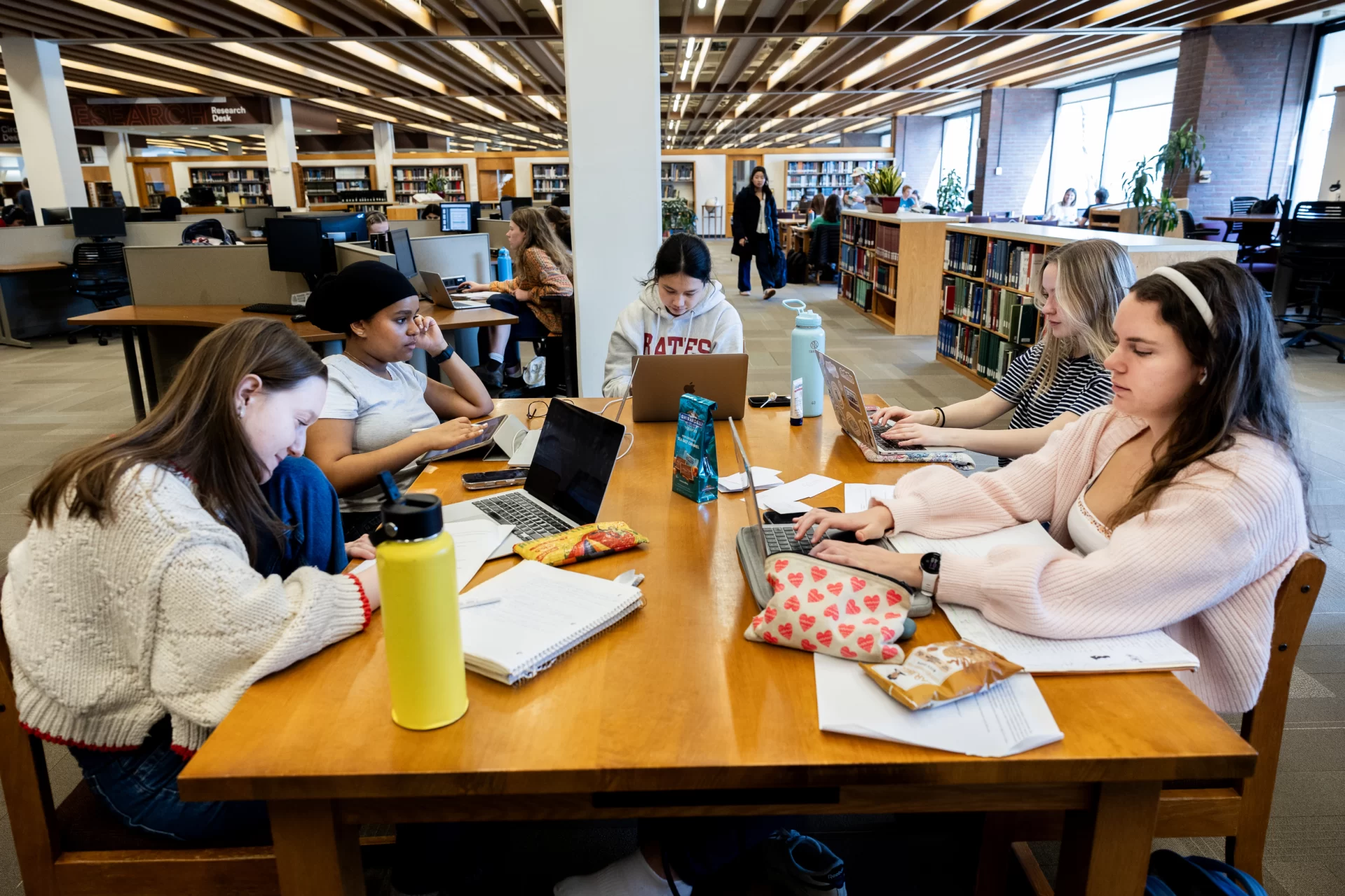
2014 Senior Thesis Exhibition features work by 10 studio art majors
Ten studio art majors at Bates College show work from their yearlong thesis projects in the annual Senior Thesis Exhibition, which opens with a public reception at 6 p.m. Friday, April 4, in the Bates College Museum of Art, 75 Russell St.
The exhibition runs through May 29. Admission is free. Regular hours are from 10 a.m. to 5 p.m. Tuesday through Saturday, but until 7 p.m. Wednesdays while Bates is in session. For more information, please call 207-786-6158 or visit bates.edu/museum.
Showing concurrently with the senior exhibition is Polish Posters: Art and Allusion, an exhibition tracing the evolution of the influential graphic arts of Poland from the 1960s into the early 2000s. Learn more about Polish Posters.
This year’s Senior Thesis Exhibition artists are Sara El Assaad of Rye, N.Y; Logan Greenblatt of South Berwick, Maine; Singha Hon of New York City; Daniel Huston of Ramsey, N.J.; Kelly Kruger of Kasota, Minn.; Alexis Martinetti of Manchester, Mass.; Julie Polizzotto of Brooklyn, N.Y.; Mahala Sacra of Wayland, Mass.; Nicole Soroka of Houston; and Douglas Welsh of Rio de Janeiro.
Since its dedication, in 1986, the Bates museum has maintained a special relationship with the college’s department of art and visual culture, expressed in part by its support of studio art majors through the Senior Thesis Exhibition.

An untitled artwork in oil paint, graphite and hair on a wooden board by Douglas Welsh, class of 2014.
As required by the studio art major, exhibiting students create a cohesive body of work through sustained studio practice and critical inquiry. The year-long process is overseen by art and visual culture faculty and culminates in this exhibition.
Here’s more about the artists and their work:
El Assaad, a woman of Lebanese descent who grew up in France, uses herself as a model for paintings that explore contrasts between Western and Middle Eastern attitudes toward sensuality and depictions of the body. “I want to create an image of anonymity that is more representative of my ideas than of any one individual,” she says. She portrays partially covered bodies “to give a sense that my subjects want to express their sensuality while remaining within the parameters of their culture’s social norms.”
Greenblatt cites large-format photographer Andreas Gursky and photorealist painter Chuck Close as influences on his photography. Greenblatt’s large images record urban landscapes, focusing on vacant buildings, as a way to explore consumer culture. “I want to highlight the visual impact of the plain, building-block style architecture found in our fast-paced industrial society,” he explains. “My goal is to comment on the contemporary, industrialized landscape of post-manufacturing cities.”
Hon’s oil paintings portray women engaged with fantastic animals. “What I want most to create are scenes of tenderness and tension that show my own difficulties in forming close relationships,” she says — hence her explorations of the symbolic power of the female form and of stylized wild animals. “The juxtaposition of animals with women, like inner wildness next to a rational brain, is strange, attractive and terrifying. . . . I hope to show the inner, primal and psychological aspects of both creatures.”
Huston uses close cropping, gestural brushwork and abstraction to create archetypal forms from nature in his paintings. One of his objectives is to depict certain forms as motifs that turn up in disparate natural phenomena. In “small, seemingly insignificant pieces of nature,” he says, “I see repetitive and provocative forms and colors as well as movement. I hope to illuminate the incredible power stored in the smallest parts of nature.”
Kruger explores the relationship between functionality and aesthetics in her pottery. Similarly, she is attracted by the notion of imposing both beauty and functionality onto the rough raw material of clay. Most of all, she makes plates and vessels whose beauty and usefulness bring people together at the table. “In creating sets of hand-made functional pottery,” she explains, “I am encouraging people to both interact with art and share their experiences with each other.”
Martinetti makes photographs of hands within domestic interior spaces with the goal of expressing moments of relationships. Inspired by film directors Cindy Sherman and Alfred Hitchcock, her work uses abstractive techniques and juxtapositions of opposites to suggest a cinematic narrative. “I am interested in capturing a unique moment within a story,” Martinetti says, “where the viewer is left to form his or her own thoughts about what just happened, what is happening now and what might happen next.”
Polizzotto has created a sculptural installation by assembling multiple hands cast in plaster. “Every hand is distinct, and the details manage to be both amorphous and exact at the same time,” she says. “I aim to shed light on this dichotomy in all of my work, and the technique of life-casting is unbeatable in helping me achieve this.”
Sacra photographs her models, seeking to elicit natural and spontaneous facial expressions, and then paints from the photos, juxtaposing their faces against incongruous geometrical backgrounds. “The designs I create are intended to allow for a complexity and intricacy of space,” Sacra explains. “I hope the interaction between figure and ground . . . will lead the viewer to think about the relationship between physical spaces and mental spaces, and the way we express our emotions using our bodies.”
Soroka’s photographs depict biomorphic forms created with draped fabrics and shaped by lighting and darkness, as well as selective depth of field and focus. “My work holds no definitive meaning,” she says. “Because of my interest in the perceptual process, I like to build and then photograph schemes in which the figure and the ground compete. Any distinction between the two therefore becomes dependent on the observer rather than on the photograph.”
Welsh produces multimedia paintings that constitute “a spiritual meeting ground for competing forces and dichotomies,” he says. “The meaning of my work is intentionally ambiguous.” His images are made from human hair and oil paint. “I find the interaction of hair and paint appealing — this combination creates organic, natural forms that are somewhat beyond my ability to control. Hair also evokes strange associations, especially when it is removed from the body.”






